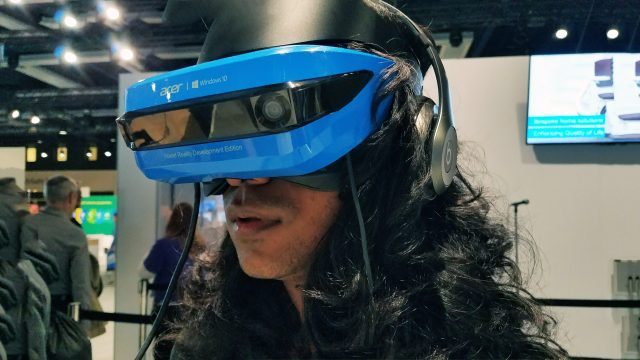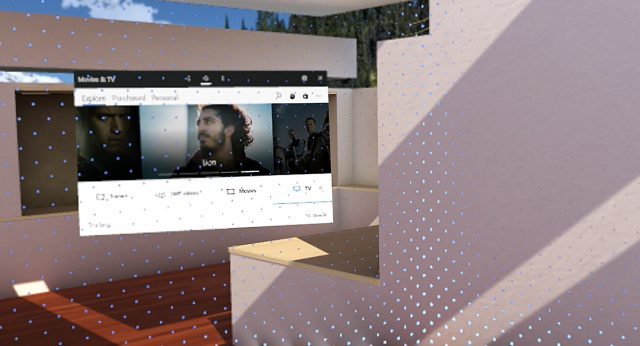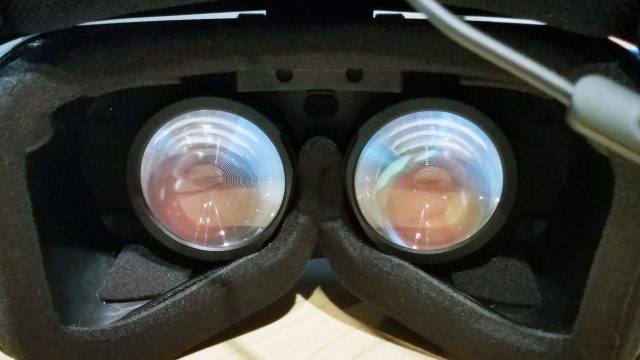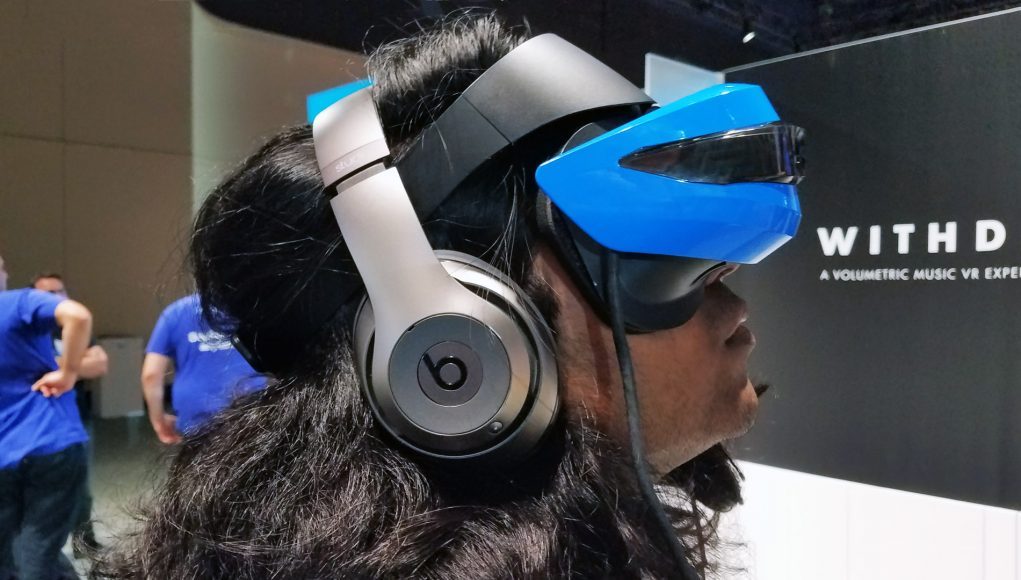Tracking

A major difference between the forthcoming Windows Mixed Reality VR headsets and the first generation of consumer PC headsets is that the Acer headset and others use inside-out tracking, which means it doesn’t rely on external beacons. That enhances the ease of setup (just plug in the headset and go!) and reduces the cost. The reason that some headsets use the other kind of tracking (outside-in), however, is because it’s very robust and high performance. To date, HoloLens is one of a small number of devices that has demonstrated good inside-out tracking, and fortunately for the Windows Mixed Reality VR headsets, Microsoft is supposedly handing over the HoloLens tech.
I found the Acer’s tracking to be quite solid in all of my demos. I did experience the occasional tiny jitter in the headset’s tracking, but nothing major. Our understanding is that the outward facing cameras on the front of the headset map your environment in much the same way as HoloLens. Using computer-vision, the cameras are able to build a model of your environment and then use that to determine where you are in that space as you move around. It’s easy to take for granted but being able to essentially plug and play with the Acer headset without finding a place for and setting up a number of external sensors is really one of the biggest values here. Given the difficulty of doing that mapping live and maintaining tracking on an expo floor where the people and objects are moving around as much as they were, I was really impressed.

One of the exhibitors who had been working with the headset for about a week mentioned that you can run the Acer VR headset in either a standing mode or a mode similar to the Vive’s chaperone boundaries. By starting the setup process and then moving the headset around your playspace you’re able to quickly create a bounding box for yourself to keep you within a certain physical area to ensure you don’t bump into things around you. I only did one or two demos where I saw this bounding box. It appeared when you approached, displayed a wall of blue dots to you, and then faded away as you stepped back into the center of your space.
Content & Windows Holographic
Since Microsoft is confusingly lumping a bunch of different things under the “Mixed Reality” term, we’re using ‘Windows Holographic’ to refer to the AR/VR portion of the Windows operating system. Windows Holographic creates an immersive virtual environment where users can interact with 2D Windows apps in the 3D virtual space, and those apps can be programmed to ‘pop out’ into the virtual space with their own 3D content, or could perhaps transport you to an entirely different virtual space when you launch a VR app.
Microsoft is working with a number of prominent PC makers to create Windows Holographic compatible headsets, like this one from Acer. However, it seems right now such headsets will rely entirely on the Windows ecosystem and won’t have an official way to play games from Oculus or SteamVR, where the majority of high-end VR entertainment content is currently available.
One demonstration of Windows Holographic in action is a demo they’re calling Cliff House. As far as I can tell, the Cliff House is meant to be a home base for you to customize with different Windows apps and content. A kind of starting-off point and place to return to between experiences, similar to Oculus Home or the SteamVR compositor. The house itself looks similar to the Bigscreen apartment environment if it were daytime out and set amongst nature. For a tour of the house you can check out this video.
The house felt like a pretty good starting point for this sort of use-case but it can still be improved in a few ways. For one I don’t remember anything moving inside the house. It felt static and dead. I also don’t remember any impressive ambient sound effects or music which might have helped to set a nice mood and establish the space. Hearing the sound of the waves breaking against the shore below the house would have done a lot to make the environment feel more alive.
I spent a few minutes teleporting around the house checking out some of the surrealist views and impossible architecture of the space, then opened up a media browser and watched a video on the Great Wall of China before my demo ended.
Another way to improve the Cliff House would be to open it up a bit more so that teleporting between rooms was easier and required less navigation. Overall I thought it was cool to have a home space that you can actually move about in, placing windows, media, and apps wherever you like, which I would desperately like to do in Oculus Home. But the house itself is still a fixer upper at this point, which is to be expected since the entire Microsoft Mixed Reality platform is currently under construction.
In addition to Windows Holographic, I saw a number of standalone demos (ie: individual VR applications), though most of the content & demos that were being shown on the headset are not worth taking the time to describe. I got the sense that almost every official demo made by Microsoft will be thrown away or not progressed much beyond remaining a traveling conference demo. I’d really liked to have seen some better content—something that highlighted the benefits of this new headset—but it just wasn’t there.

Most of the official demo stations were either seated or in such a compact space that the headsets were in standing-only mode. It’s a shame Microsoft couldn’t put together some demos that would have allowed users to move around more and really get a sense for the “world scale” tracking. From the demos I received it felt more like chair-scale tracking or rug-scale tracking since I was told to stand in the middle of a 2 x 3 ft matt at one station and not step off it. I’m probably being too harsh given the early nature of both the headsets and the entire Microsoft Mixed Reality platform, but it would have been nice to have seen some more engaging content; something that got the blood pumping, had some basic engaging gameplay, or hit me on an emotional level.
One Acer demo that stood out and actually allowed me to move around to test the tracking capabilities of the headset, was a volumetric music video experience created by Viacom NEXT. The experience features recording artist Max Frost and was made in partnership with Microsoft using their Holocapture system.
The quality of the human representation that resulted from the capture process was much better than anything I had seen previously. I’ve seen a few companies try to stitch stuff like this together in the past using multiple Kinect sensors and the like, but the quality here was on another level. Aesthetically the experience reminded me of inhabiting a music video based on the 1996 film Multiplicity along with some SpongeBob influences due to the underwater and beach locations. The Acer VR headset provided comfortable tracking as I moved around and tested the bounds of the playspace.
After my demo I watched someone else go through the experience and noted two things: 1) the headset seems to accommodate those wearing glasses well, both in this instance and in others that I saw, 2) the cable looks to be about 12 or 13 ft in length, which was not enough in this instance when the gentleman walked back to the edge of the playspace and almost pulled the demo computer off its perch. To compare, the Vive cable is approximately 19 ft in length including the breakout box to the PC, and the Rift cable is approximately 13 ft long.
Another exhibitor demo I was impressed with was Pixvana’s VR video technology running on the Acer headset. The high resolution panel in the Acer really lent itself well to the HQ 360 video experience. I’m unsure what resolution the Seattle Sounders game day experience I watched was playing back at, but Pixvana says they can stream video content up to 12k resolution. They recently announced a partnership with Valve that has their technology working at the core of the Steam 360 video player. Due to the Acer headset’s higher resolution and huge portability benefits, it could become a favorite of the VR video community for playback on location, demos, and long editing sessions made more tolerable by the headsets ‘flip up’ ability.







